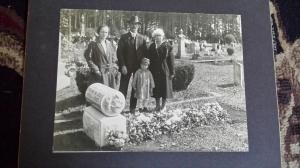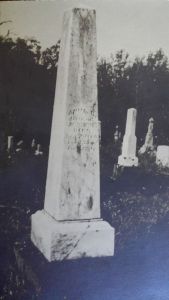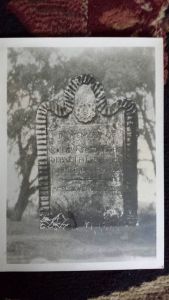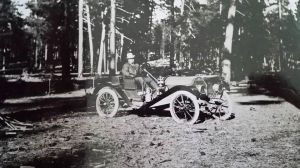Found these photos on ebay out of Oregon. They also were in the same batch as the Whitehead photo blog, not sure that there is any relation between those and these photos but I make notes just in case.
Back of Photo reads “Woodburn Cemetery” Mabel Bowles, Frank Coy, Edna Nelson and Willard Bowles (child)
Photo is at Woodburn Cemetery in Marion County, Oregon. (click on the images to enlarge) It is the grave covered in a large amount of flowers for Frank’s wife EMMA. Born in 1862 and died in 1907. She was 45 yrs old at her death. Im wondering if this was her funeral? Or just visiting the grave. It is a beautiful photo.
Frank is the man in the photo, I believe his daughter Mabel Loretta Coy Bowles is on the left side. (following the order names are written on back). Edna Nelson on the other side is his other daughter. On findagrave it says that Frank Coy passed away at the home of his daughter Edna’s home in 1948. Willard Bowles is the little boy and is the son of Mabel. Born in 1915 and died in 2001.
Head Stone for
John Milton Forrest – Born 1808 Died 1865. Anna Bell Rhea Forrest Born 1810 Died 1866.
You can see their photo on Findagrave at his link, it also says they led a wagon train crossed the Oregon Trail .
http://findagrave.com/cgi-bin/fg.cgi?page=pv&GRid=10307503&PIpi=37399733
Has writing on the back of the photo of the stone that reads “Headstone at the grave of Judge John M. Forrest and Anna Bell Rhea Forrest in Hopewell Cemetery. Albany, Oregon
Last stone photograph says on the back “Memorial stone at the grave of Nickolas / Nicholas Darter Sr., in the cemetery adjoining the old Saint Johns Church near Wytheville, Va. This stone is still standing (1942) The snap shot from which this photograph was made was taken by Michael E. Darter of Washington D.C. This background is not the original which is tall dry grass. This background was made of an old picture used for the purpose. The foundation has sunken into the ground in the one hundred and twenty three years since it was erected. Born Mar 12, 1746 Died April 8, 1821.”
You can actually find the will written by Nicholas Darter which is fascinating. Then there is a detailed list of his possessions and their values.
“I Nicholas Darter Sr., of Wythe Co., do make this last will & testament in
the following manner: 1st to wit, After the payment of all my just debts
out of my estate by my executor herein named. I give unto my wife Finwell
Darter $100.00 in money and all my household and kitchen furniture except
two beds, one Cupboard and the clock. 2nd, I give to my sons Nicholas and
John one dollar each and no more. 3rd, I give unto my sons Henry and
Michael and to my daughter Catherine Robinet, Barbara Repass, Elizabeth
Henderson,Rosina Day, and the children of my personal estate to be equally
divided among them and the children of my aforenamed daughter, Magdellina
shall recieve together but one equal share thereof. 4th, Whereas John
Henderson who is entermarried to my aforenamed daughter Elizabeth has
already recieved the sum of $76.00 it is my wish that the said sum be
deducted out of his share and be equally divided equally among my named
children, Nicholas, and John excepted. 5th, I also give to my wife Finwell
my negro woman named Rachel during her life and after the decese it is my
will that the said Rachel shall remain three months with my executor
hereafter mentioned and shall have the privilege during the said time to
choose a master, provided the person chosen by the said Rachel shall be
willing to allow for her what she may be valued to by two disinterested
men chosen by my executor for that purpose and in case the said Rachel can
not be disposed of in that way during the three months, it is my will that
she shall be sold by my executor and the money therefrom divided equally
amongst all my children (Nicholas and John excepted) and allowing to the
children of my daughter Magalene (sic) Repass one full share. 6th, I
constitute and appoint my friend Christopher Brown executor of this my
Will and testament, hereby revoking all former wills and testaments
heretofore by me made.”
More of this will can be found here….
http://familytreemaker.genealogy.com/users/d/i/l/Lawrence-Dillard-Fl/WEBSITE-0001/UHP-0090.html
And his photo can be found on findagrave here
http://findagrave.com/cgi-bin/fg.cgi?page=pv&GRid=28484955&PIpi=39802463
These 4 other photos also came in this batch, not sure if there is any relation and there are no markings on them.
2 women and a man walking across a bridge
Chapel
Man in Old Car in front of trees
This last one looks like a copy of a photo with a note attached that says below “A.S. Johnston” Autograph found inside the cover of General Johnston’s Pocket-Map of Tennessee, and written three days before the Battle of Shiloh – Probably his last autograph.”
Albert Sidney Johnston
(February 2, 1803 – April 6, 1862) served as a general in three different armies: the Texian (i.e., Republic of Texas) Army, the United States Army, and the Confederate States Army. He saw extensive combat during his military career, fighting actions in the Texas War of Independence, the Mexican-American War, the Utah War, and the American Civil War.
Considered by Confederate President Jefferson Davis to be the finest general officer in the Confederacy before the emergence of Robert E. Lee, he was killed early in the Civil War at the Battle of Shiloh. Johnston was the highest-ranking officer, Union or Confederate, killed during the entire war.[1] Davis believed the loss of Johnston “was the turning point of our fate”.
From Wikipedia (and this is just a section! There is a lot written about him)
http://en.wikipedia.org/wiki/Albert_Sidney_Johnston
Battle of Shiloh and death
Johnston launched a massive surprise attack with his concentrated forces against Grant at the Battle of Shiloh on April 6, 1862. As the Confederate forces overran the Union camps, Johnston seemed to be everywhere, personally leading and rallying troops up and down the line on his horse. At about 2:30 p.m., while leading one of those charges against a Union camp near the “Peach Orchard”, he was wounded, taking a bullet behind his right knee. He apparently did not think the wound was serious at the time, or even possibly did not feel it, and so he sent his personal physician away to attend to some wounded captured Union soldiers instead. It is possible that Johnston’s duel in 1837 had caused nerve damage or numbness to his right leg and that he did not feel the wound to his leg as a result. The bullet had in fact clipped a part of his popliteal artery and his boot was filling up with blood. Within a few minutes, Johnston was observed by his staff to be nearly fainting. Among his staff was Isham G. Harris, the Governor of Tennessee, who had ceased to make any real effort to function as governor after learning that Abraham Lincoln had appointed Andrew Johnson as military governor of Tennessee. Seeing Johnston slumping in his saddle and his face turning deathly pale, Harris asked: “General, are you wounded?” Johnston glanced down at his leg wound, then faced Harris and replied in a weak voice his last words: “Yes… and I fear seriously.” Harris and other staff officers removed Johnston from his horse and carried him to a small ravine near the “Hornets Nest” and desperately tried to aid the general by trying to make a tourniquet for his leg wound, but little could be done by this point since he had already lost so much blood. He soon lost consciousness and bled to death a few minutes later. It is believed that Johnston may have lived for as long as one hour after receiving his fatal wound. Harris and the other officers wrapped General Johnston’s body in a blanket so as not to damage the troops’ morale with the sight of the dead general. Johnston and his wounded horse, named Fire Eater, were taken to his field headquarters on the Corinth road, where his body remained in his tent until the Confederate Army withdrew to Corinth the next day, April 7, 1862. From there, his body was taken to the home of Colonel William Inge, which had been his headquarters in Corinth. It was covered in the Confederate flag and lay in state for several hours.
It is probable that a Confederate soldier fired the fatal round. No Union soldiers were observed to have ever gotten behind Johnston during the fatal charge, while it is known that many Confederates were firing at the Union lines while Johnston charged well in advance of his soldiers.
Johnston was the highest-ranking casualty of the war on either side, and his death was a strong blow to the morale of the Confederacy. Jefferson Davis considered him the best general in the country; this was two months before the emergence of Robert E. Lee as the pre-eminent general of the Confederacy.
This was a curious grouping of photos. Not sure if the seller just compiled them together or if they were in a group together.









the first photo is great. The will is fascinating too.
Some of those old wills are totally confusing — lots of “conditional” bequests, and this seems like one of them–almost too complicated to follow! Great old photos!
I especially like the first photo with the different stone and the family.
That’s quite a mix of photos if they are all related.
In my back garden is a stone marker for a great great uncle who lived in Minnesota. Somehow his family made a second larger gravestone to replace the first, which my mom and I rescued from the cemetery dump and took back to Virginia. It then traveled to Savannah, Georgia where I once lived, and now it is in the mountains of NC. Though only a 3 feet tall square column it is very very very heavy! Maybe one day it will return to Minnesota.
The information about the Battle of Shilho was quite fascinating, the name I knew, but I never knew it within its historical context. And you are right to remind us of the importance of gravestones, which along with old photographs, are the building blocks of ordinary history.
What a sad but beautiful photo that first one is.
Great research. I’m glad the photos have found a good home:) Someone will recognise the names one day, I’m sure.